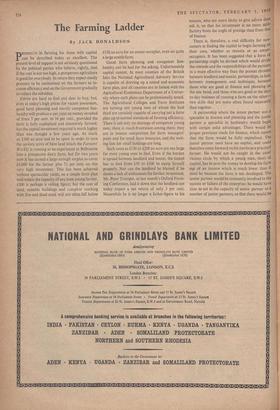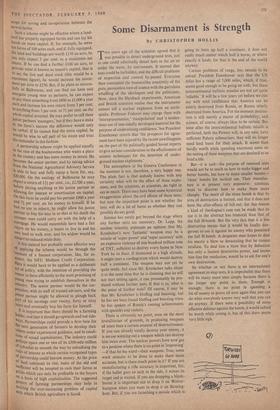The Farming Ladder
By JACK DONALDSON 111ROSPECTS in farming for those with capital r can be described today as excellent. The present level of support is not seriously questioned by the political parties who believe, rightly, that if the cost is not too high, a prosperous agriculture is good for everybody. In return they expect steady pressure to be maintained on the farmers to in- crease efficiency and on the Government gradually to reduce the subsidies.
Farms are hard to find and dear to buy, but, even at today's high prices for vacant possession, good farm planning and merely competent hus- bandry will produce a net yield on money invested of from 5 per cent. to 10 per cent., provided the farm is fully capitalised and intensively farmed; but the capital investment required is much higher than was thought a few years ago. As much as £300 an acre had to be spent in order to turn the seventy acres of bare land which the Farmers' Weekly is running as an experiment at Bulbourne into a prosperous dairy farm, but for two years now it has earned a large enough surplus to cover £1,000 for the farmer plus 71 per cent. on this very high investment. This has been achieved without spectacular yields, on a simple farm plan well within the capacity of any keen young farmer. £300 is perhaps a ceiling figure; but the cost of land, suitable buildings and complete stocking with live and dead stock will not often fall below £150 an acre for an owner-occupier, even on quite a large arable farm.
Good farm planning and competent hus- bandry can be had for the asking. Unfortunately capital cannot. In most counties of the British Isles the National Agricultural Advisory Service is capable of drawing up a sound and economic farm plan, and all counties are in liaison with the Agricultural Economics Department of a Univer- sity where such plans can be professionally tested. The Agricultural Colleges and Farm Institutes are turning out young men of whom the best third are certainly capable of carrying out a farm plan up to normal standards of farming efficiency. There is. not only no shortage of competent young men; there is much frustration among them; they are in intense competition for farm managers' posts and for small farm tenancies, and the wait- ing lists for small holdings are long.
Such sums as £150 or £200 an acre are too large for most young men to find. Even if the burden is spread between landlord and tenant, the tenant has to find from £50 to £100 to equip himself properly. Nor can the landlord be blamed if he shows a lack of enthusiasm for further investment. Mr. Peter Trumper, at last month's Oxford Farm- ing Conference, laid it down that the landlord can today expect a net return of only 3 per cent. Meanwhile he is no longer a father-figure to his tenants, who are more likely to give advice than ask it, so that his investment is no more says- factory from the angle of prestige than from that of finance.
There is, therefore, a real difficulty for noxl• corners in finding the capital to begin farming on their own, whether as tenants or as owner. occupiers. It has been suggested that a form of partnership might be devised which would divide the rewards and the responsibilities of the partners in a more effective way than the present division between landlord and tenant; partnerships, in fact, between management and technique, between those who are good at finance and planning on the one hand, and those who are good at the day to-day business of running a farm on the other-- two skills that are more often found separately than together.
A partnership where the senior partner was 3 specialist in finance and planning and the junior partner a specialist in husbandry would begin with certain solid advantages. There would be proper provision made for finance, which means that the farm would be fully capitalised. The junior partner need have no capital, and could therefore come forward on his merits as a practical farmer. He would not be caught in the usual vicious circle by which a young man, short Of capital, has to save the money to develop his farm out of an income which is much lower than it need be because the farm is not developed. The senior partner would be intimately involved in the success or failure of the enterprise; he would have time to act in the capacity of senior partner to a number of junior partners, so that there would be scope for saving and co-operation between the several farms.
Such a scheme might be effective where a land- lord has properly equipped farms and can lay his hands on more capital. lf, for example, he owns ten farms of 100 acres each, and if, fully equipped, the land and buildings are worth £150 an acre, he Can only expect 3 per cent. as a maximum net return. If he can find a further £100 an acre, to provide what is known as tenant's capital, that is to say the live and dead stock (this would be a maximum figure), he would increase his invest- ment per acre to £250. But, if he plans as success- fully as Bulbourne, and can find ten keen and energetic young men as partners, he can expect to Pay them something from £800 to £1,000 a year each and increase his own return from 3 per cent. to anything from 5 per cent. to 74- per cent. on the Whole capital invested. He may prefer to call these junior partners 'managers,' but if they have a stake In the farm's success the difference would only be verbal. If he cannot find the extra capital, he would be wise to sell part of his estate and treat the remainder in this fashion.
A partnership scheme might be applied equally to the case of the businessman who wants a place to the country and has some money to invest. He becomes the senior partner, and by taking advice from the National Agricultural Advisory Service Is able to buy and fully equip a farm for, say, £20,000. On the analogy of Bulbourne he may expect a return of 121 per cent., i.e., £2,500 a year, before paying anything to his junior partner or allowing for interest or amortisation on capital. On this basis he could pay his partner £900 a year and 71 per cent. on his money to himself. If he had no son to inherit, he might allow his junior Partner to buy his way in so that at his death the Younger man could carry on with the help of a Mortgage. He would meanwhile have had a fair return on his money, a house to live in and his Own land to walk over, and his widow would be subject to reduced estate duty. .A less natural but probably more effective way 1 applying the scheme would be through the medium of a finance corporation, like, for in- stance, the NFU Medium Credit Corporation. Here it would have to be applied as a deliberate act of policy, with the intention of providing the means to farm efficiently to the most promising of ?Ming men trying to establish themselves in the Industry. The senior partner would be the cor- poration, with its staff of trained advisers, and the Junior partner might be allowed to plough back Pa" of his earnings over twenty, forty or sixty Years and eventually buy his farm for himself. It is impOrtant that there should be a farming ladder, and that it should go upwards and not side- Ways. Partnerships could provide a firm base for the next generation of farmers to develop their talents under experienced guidance, and in condi- tions of sound capitalisation. The industry could Perhaps spare one or two of its £300-odd million of subsidies to smooth the way by subsidising the rates of interest at which certain recognised types of Partnership could borrow money. As the price Of land continues to rise, more of the old and Inefficient will be tempted to cash their farms at prices which can only be profitable to the buyers on a basis of high capitalisation. The suggested Pattern of farming partnerships may help in tackling the ever-increasing problem of capital With which British agriculture is faced.











































 Previous page
Previous page